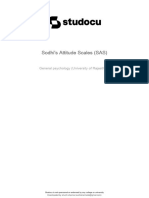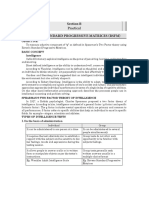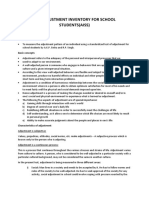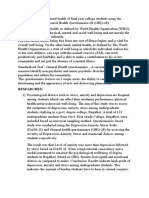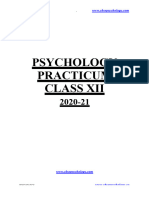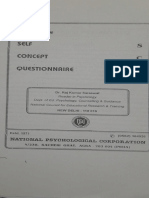100%(3)100% found this document useful (3 votes) 9K views8 pagesSelf Concept Questionnaire Manual
Copyright
© © All Rights Reserved
We take content rights seriously. If you suspect this is your content,
claim it here.
Available Formats
Download as PDF or read online on Scribd
a
MANUAL | | _/ “|
FOR
SELF CONCEPT QUESTIONNAIRE
Dr. Raj Kumar Saraswat
“Reader in Psychology
Dept. of Education, Psychology, Counselling & Guidance
National Council for Educational Research & Training
NEW DELHI-110 016
TM Re
Copyright Regd. No. © A-7
0005 Dt. 135.05,
Estd. : 1971 © : (0562) 2464926 |]
anki PSYCHOLOGICAL CORPORATION |
E 2 4/230, | KACHERI GHAT, AT, AGRA-282 82 004�MANUAL
FOR
SELF CONCEPT QUESTIONNAIRE ’
(S C Q)
INTRODUCTION
Self-concept is a dominant element in personality pattern, therefore, the
measurement of self-concept becomes essential. A variety of methods and
techniques have been developed to measure self-concept. The problem of
measuring the self-concept to a large extent still remains unsolved. The difficulty
in conducting research in such an area is that the concept of self is not very well
defined and is in a state of flux. There are several terms that are virtually
synonymous with self-concept among them are “Self-image”, the “Ego”
“Selfunderstanding”, "Seltperception” and “Phenomenal Self” he
we
iananntte
Self-concept has been referred by Lowe (1961) as one’s attitude towards
self, and by Paderson (1965) as an organized configuration, of perceptions,
beliefs, feelings, attitudes and values which the individual views as a Part of
characteristics of himself. Rogers (1951) defined self-concept as “An organized
configuration of perceptions of the self which are admissible to awareness. It is
es of ‘elements as the perceptions of one’s characteristics and
sa ‘ee and concepts of the self in relation to others and to the
ar he value q Ss which are perceived as associated with
S and ideals which�Lynche, Norem-Hebeisen and Gergen (1981) have
itt's
Uggestion that attention should be shifted from global measures of the
? — ne UlSS Of thi
Self-concept to configurations of responses across self-concept dimensions.
Such configurational patterns should be mere sensitive to environmental effects.
An examination of various instruments developed to measure self-concept
~
3veals that these measures have not incorporated many important components
f self-concept presumed in theory and in observation. These Measures do not
eal with all aspects of self-concept, but Provide narrow and limited information
pending upon Purpose and interest of investigators.
Adolescence. is a period of life with its own peculiar characteristics and
roblems. Hence for deep penetration into their perceptions their own physical, 1
Scial, temperamental, educational, moral and intellectual spheres of self- :
2ncept need to be explored. As such, an attempt has been made in this
_ Jestionnaire for eliciting information regarding adolescent’: NS ani
Jaracteristics,)
escription of Self-Concept Inventory t
The self-concept inventory provides six separate dimensions of \
salf-concept, viz., physical, Social, Intellectual, Moral, Educational and
temperamental Self-concept. It also gives a total self-concept score. The
sperational definitions of self-concept dimensions measured by this inventory
e:
| 1. Physical — Individuals’ view of their body, health, physical annearance and
strength. pie Gi
2. Social — individual's sense of worth in social interactions.
be
Temperamental — Individuals view of their�4. Educational —Individual’s view of themselves in relation to school, teachers
and extracurricular activities.
5. Moral—Individual’s estimation of their moral worth; right and wrong
activities.
6. Intellectual —Individuals’ awareness of their intelligence and capacity of
problem solving and judgements.
Table 1 indicates item numbers included in different self-concept
dimensions
TABLE 1
Self-concept Dimensions Alongwith their tem Numbers
_
{ Self-concept Dimensions | Code No. Item Numbers
Physical A 2,3,9, 20, 22, 27, 29,31
Social B_ | 1.8,21,37, 40, 43, 46, 48
Temperamental ic 4,10, 14, 16, 18,23, 24, 28 |
Educational D 5,13, 15, 17, 25, 26,30,32 |
E
F
6, 34, 35, 41, 42, 44, 45, 47
7,11, 12, 18, 33, 36, 38, 39
| Moral
| Intellectual
| cw. The inventory contains 48 items. Each dimension contains eight items. Each
item is provided with five alternatives. Responses are obtained on the test booklet
| itself There is no-time Jimit but generally 20 minutes have been found sufficient for
responding ail the items. Instructions for the time of administration of the inventory
}
|
are also given on the test booklets.
Instructions for Administering the Inventory
4. Let the students be seated with proper seating arrangement.
2 Before the test starts, let all books and note-books be kept�Make sure that the respondent has a pencil or pen,
Tell students the Purpose of the test.
Assure students that the responses obtained on the test will be kept secret.
Any doubts raised by the students should be answered frankly.
Distribute the test booklet of Seit- ‘Concept inventory to the students.
Let all the entries of the response booklet be filled in one by one.
Read the instructions Clearly from the test booklet, while the individuals read
silently.
Ensure that the instructions have been understood correctly.
Invite doubts or querries and clear them before they start responding the
items.
Supervise the group, i. e. take rounds in the room and make sure that all are
responding in a desired way.
= 2 Ss hy
If Someone needs to know the meaning of certain words, he/she should be
told. However the responses have to be decided independently by the
candidates themselves.
14. Count the test booklets at the end of the testing and be sure that all the test
booklets have been returned.
Instructions to Students
Read the following instructions from the inventory in Hindi of English-as the
case may be —
“The is a self-concept inventory. There are 48 items in it. Against each item
there are five responses. You have to read each item carefully and respond to it by
marking atick (V ) on any ‘one of the five responses given against that item, which�8 | Manual forS CQ
There is no right or wrong answer. The right answer is only what you feel
about yourself. Try to give your responses according to what you feel about
yourself with reference to that a statement. Your answers will be kept confidential.”
\-After the above instructions, administrator should explain the EXAMPLE
given on the inventory.
Scoring Method
The respondent provided with five alternatives to give his responses ranging
from most acceptable to least acceptable description of his self-concept. The
alternatives or responses are arranged in such a way that the scoring system for
all the items will remain the same i.e. 5, 4, 3, 2, 1 whether the items are positive or
negative. If the respondent put ( v ) mark for first alternative the score is 5, for
second alternative the score is 4, for third alternative score is 3, for the fourth it is 2
and for the fifth and last alternative the score is one. The summated score of all
the forty-eight items provide the total self concept score of an individual. A high
score on this inventory indicates a higher self-concept, while a low score shows
low self-concept. Transfer the score of each item on the front page against that
item. Now add all the scores of eight items given in that column, this will give you
score for that particular dimension of Self-concept.
Reliability
\ ee of the inventory was found by resets maths, and it�TABLE 2
Test-Retest Reliability of the Self-concept Inventory
Code No. Self-concept Dimension | No. of Items | Reliability Coefficients
A Physical 8 77
B _|__ Social 8 83
aes ‘Temperamental 8 73
D Educational 8 88
& Moral 8 67
F Intellectual 8 79
ie Total Self-Concept ag Fl 91
Validity
Experts opinion were obtained to establish the validity of the inventory. 100
items were given,to 25 psychologists to classify the items to the category to which
it belongs. Items of highest agreement and not less than 80% of agreement were
selected. Thus the content and construct validity were established
Standardization and Norms
The Self-concept Questionnaire was standardized on 1000 students of 20
Higher Secondary school of Delhi pertaining to Delhi Administration and Central
Schools. The students were from IXth and Xth classes ranging from 14 to 18
years of both the sexes
TABLE 3
Interpretation and Classification of Raw Scores for all Dimensions
Self-conceptDimension Score | Interpretation (Category)
33to 40 High Self-concept
25 to 32 Above Average Self-concept |
17to 24 Average Self-concept |
90 16 Below Average Self-concept
Upto 8 Low Self-concept�TABLE 4 3
Interpretation and Classification of Raw Scores for otal Self.
Concept
Raw Score Interpretation
193 to 240 High Self-concept
145 to 192 Above Average Self-concept
97 to 144 Average Self-concept
49 to 96 Below Average Self-concept
1to 48 Low Self-concept
REFERENCES
Lowe, C. M. (1961). The Self-concept : Fact or artifact ? Psychological Bulleti
58, 325-326.
Lynche, M.D. ; Norem-Hebeisen, A.A. and Gergen, K.J. (1981). Sei
Contemplations-self-concept, Advance in Theory and Research:
Cambridge, Mass Ballinger.
Pedersen, D. M. (1965). Ego strength and discrepancy between conscious and
unconscious self-concept. Perceptual and Motor skills, 20, 691-692.
Rogers, C. R. (1951). Client Centered Therapy —its current Practice, Implications
and Theory. Boston, Houghton.
Saraswat, R. K. and Gaur, J.S. (1981). Approaches for the measurement of self
concept — An Introduction. Indian Educational Review, 16(3), 114-119.
© 2011 . Al rights reserved. No portion of this inventory material should be rep
«A ten permission of the publisher, Manual or Sell- Concept Questonnaie









